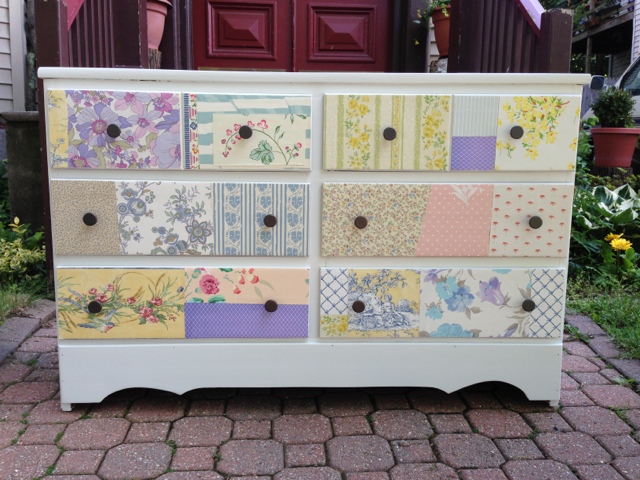Recently I was approached to recreate a beautiful dresser with a staggering price tag. The Collage Dresser retails for $799 and I’m sure it’s well worth it- the dresser is lovely- but “in this economy” (aka the catch phrase of the 21st century) who can really afford it? The recipient also wanted a decidedly less “shabby chic” version of the dresser with no distressing or faux wear on the paper.
To make this dresser I started out with my basic supplies. My client already had an old cheap dresser in her house so we saved money on having to buy one though you can always find cheap dressers on
Craigslist if you were looking to do this project. Cost of project: $0.00
I also had some semi-gloss, oil-based white paint left over from another project and used that to paint the dresser. It’s a good idea to use a gloss or semi-gloss on dressers so that you can wipe them down if necessary. I did 3 coats of the white with a roller. So far the cost of this project is still $0.00. Excellent.
I ordered some vintage wallpaper on Etsy from 2 shops,
Vintage Sheet Addict and
Threads & Memories, I spent about $16 at each shop and the paper is awesome. There were so many cool designs it was really hard to decide which ones made the cut. Cost of project now: $32.
I laid the paper out on the drawers and experimented with placement until it looked right.
One drawer in particular gave me a considerable amount of trouble. I got it right on the 3rd attempt.
I glued the wallpaper in place using
Tacky Glue and then smoothed it out using a brayer. (You can find them both at Michael’s, AC Moore, Blick, etc.) This worked better than Modge Podge because since this is vintage wallpaper that’s been rolled up for God knows how long- it didn’t lay as well as regular paper would and the corners kept curling up on me. Because the Tacky Glue is true to it’s name and “tacky”, it was easier to make the edges stick to the drawer.

Then I spent $10 on some basic black knobs from the Target General Super Store and my dresser was complete. Bringing my grand total to $42 and some change. Not bad considering this project was done as a trade- I got to spend a week at my client’s house on Cape Cod in exchange for creating this dresser for her. I think I got the better end of this bargain.
Thanks for coming by! I hope you liked my project. If you did, let me know in the comments below and don’t forget to go “like” me on Facebook. (I told my Mom I was popular…I don’t want to disappoint her.)









